window HONDA HR-V 2018 Owner's Manual (in English)
[x] Cancel search | Manufacturer: HONDA, Model Year: 2018, Model line: HR-V, Model: HONDA HR-V 2018Pages: 503, PDF Size: 32.79 MB
Page 4 of 503
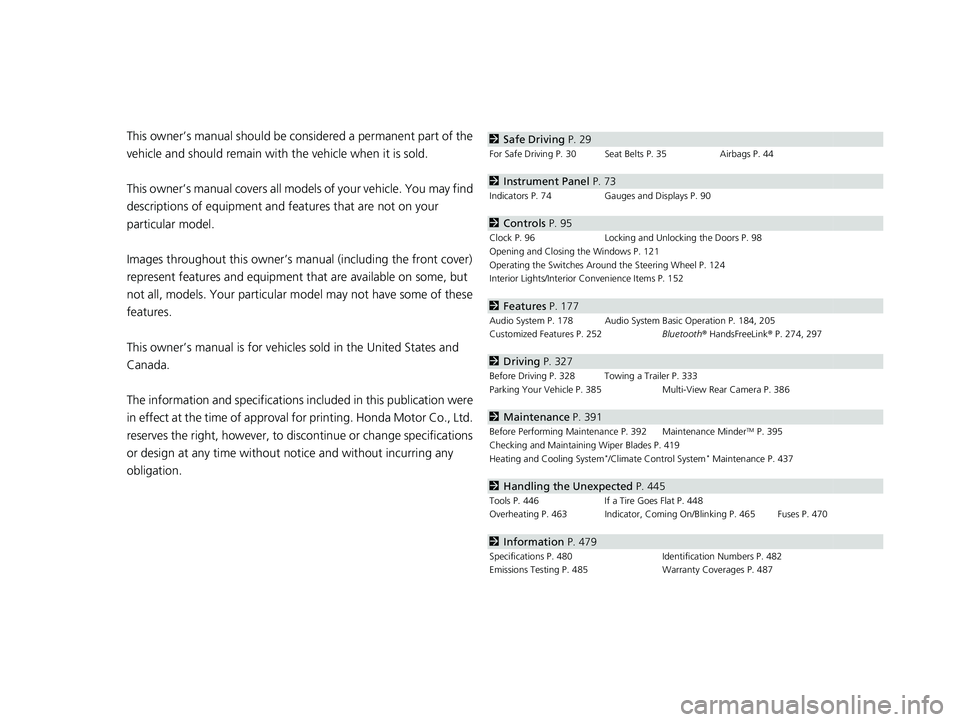
Contents
This owner’s manual should be considered a permanent part of the
vehicle and should remain with the vehicle when it is sold.
This owner’s manual covers all models of your vehicle. You may find
descriptions of equipment and features that are not on your
particular model.
Images throughout this owner’s manual (including the front cover)
represent features and equipment that are available on some, but
not all, models. Your particular mo del may not have some of these
features.
This owner’s manual is for vehicles sold in the United States and
Canada.
The information and specifications in cluded in this publication were
in effect at the time of approval for printing. Honda Motor Co., Ltd.
reserves the right, however, to discontinue or change specifications
or design at any time without notice and without incurring any
obligation.2 Safe Driving P. 29
For Safe Driving P. 30 Seat Belts P. 35 Airbags P. 44
2Instrument Panel P. 73
Indicators P. 74 Gauges and Displays P. 90
2Controls P. 95
Clock P. 96 Locking and Unlocking the Doors P. 98
Opening and Closing the Windows P. 121
Operating the Switches Around the Steering Wheel P. 124
Interior Lights/Interior Convenience Items P. 152
2 Features P. 177
Audio System P. 178 Audio System Basic Operation P. 184, 205
Customized Features P. 252 Bluetooth® HandsFreeLink ® P. 274, 297
2 Driving P. 327
Before Driving P. 328 Towing a Trailer P. 333
Parking Your Vehicle P. 385 Multi-View Rear Camera P. 386
2Maintenance P. 391
Before Performing Maintenance P. 392 Maintenance MinderTM P. 395
Checking and Maintaining Wiper Blades P. 419
Heating and Cooling System
*/Climate Control System* Maintenance P. 437
2 Handling the Unexpected P. 445
Tools P. 446 If a Tire Goes Flat P. 448
Overheating P. 463 Indicator, Coming On/Blinking P. 465 Fuses P. 470
2 Information P. 479
Specifications P. 480 Identification Numbers P. 482
Emissions Testing P. 485 Warranty Coverages P. 487
18 HR-V-31T7A6200.book 2 ページ 2017年6月30日 金曜日 午後1時23分
Page 6 of 503
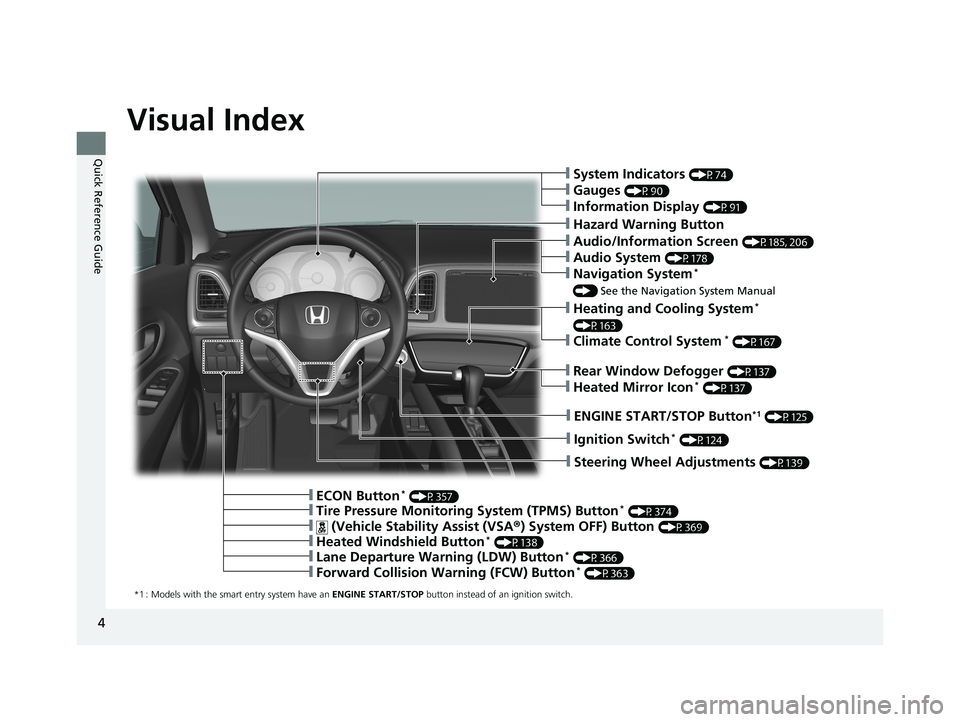
4
Quick Reference Guide
Quick Reference Guide
Visual Index
*1 : Models with the smart entry system have an ENGINE START/STOP button instead of an ignition switch.
❙ENGINE START/STOP Button*1 (P125)
❙Steering Wheel Adjustments (P139)
❙Hazard Warning Button
❙Ignition Switch* (P124)
❙Tire Pressure Monitoring System (TPMS) Button* (P374)
❙ (Vehicle Stability Assist (VSA ®) System OFF) Button (P369)
❙Heated Windshield Button* (P138)
❙Lane Departure Warning (LDW) Button* (P366)
❙Forward Collision Warning (FCW) Button* (P363)
❙ECON Button* (P357)
❙System Indicators (P74)
❙Gauges (P90)
❙Information Display (P91)
❙Audio/Information Screen (P185, 206)
❙Audio System (P178)
❙Navigation System*
() See the Navigation System Manual
❙Heating and Cooling System*
(P163)
❙Climate Control System* (P167)
❙Rear Window Defogger (P137)
❙Heated Mirror Icon* (P137)
18 HR-V-31T7A6200.book 4 ページ 2017年6月30日 金曜日 午後1時23分
Page 8 of 503
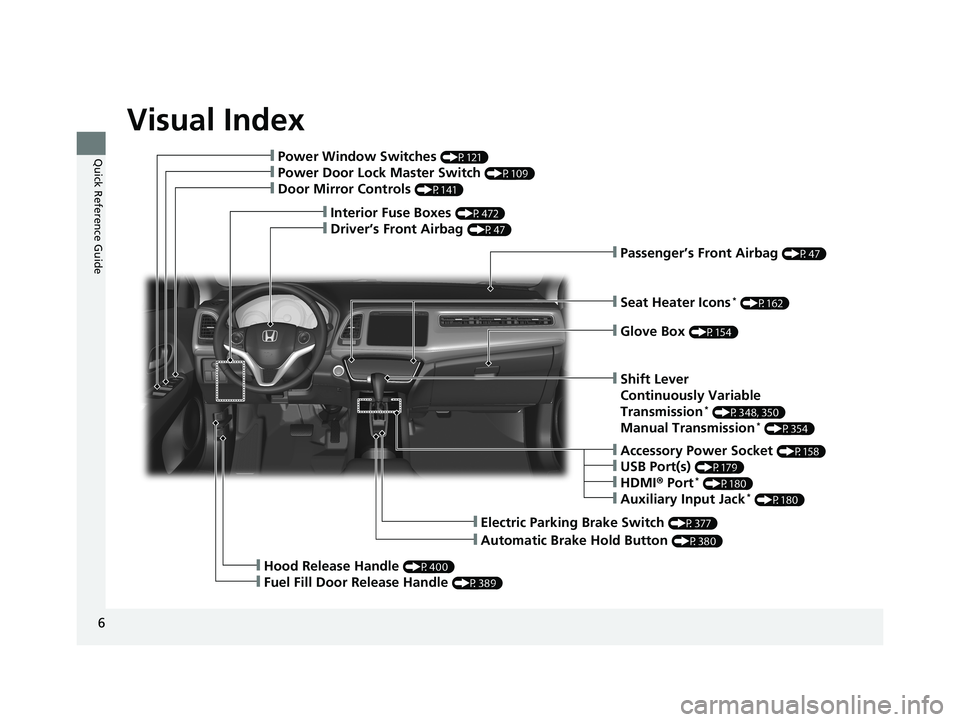
Visual Index
6
Quick Reference Guide
❙Electric Parking Brake Switch (P377)
❙Hood Release Handle (P400)
❙Fuel Fill Door Release Handle (P389)
❙Passenger’s Front Airbag (P47)
❙Interior Fuse Boxes (P472)
❙Driver’s Front Airbag (P47)
❙Power Window Switches (P121)
❙Power Door Lock Master Switch (P109)
❙Door Mirror Controls (P141)
❙Automatic Brake Hold Button (P380)
❙Seat Heater Icons* (P162)
❙Glove Box (P154)
❙Accessory Power Socket (P158)
❙USB Port(s) (P179)
❙HDMI® Port* (P180)
❙Auxiliary Input Jack* (P180)
❙Shift Lever
Continuously Variable
Transmission
* (P348, 350)
Manual Transmission* (P354)
18 HR-V-31T7A6200.book 6 ページ 2017年6月30日 金曜日 午後1時23分
Page 17 of 503

15
Quick Reference Guide
Power Door Mirrors
(P141)
●With the ignition switch in ON
(w*1, move
the selector switch to L or R.
● Push the appropriate edge of the
adjustment switch to adjust the mirror.
*1 : Models with the smart entry system have an
ENGINE START/STOP button instead of an ignition
switch.
Selector Switch
Adjustment Switch
Power Windows (P121)
● With the ignition switch in ON
(w*1, open
and close the power windows.
● If the power window lock button is in the
off position, each passenger’s window
can be opened and closed with its own
switch.
● If the power window lock button is in the
on position (indicator on), each
passenger’s window switch is disabled.
Power Window Lock Button
Window Switch
Indicator
18 HR-V-31T7A6200.book 15 ページ 2017年6月30日 金曜日 午後1時23分
Page 25 of 503
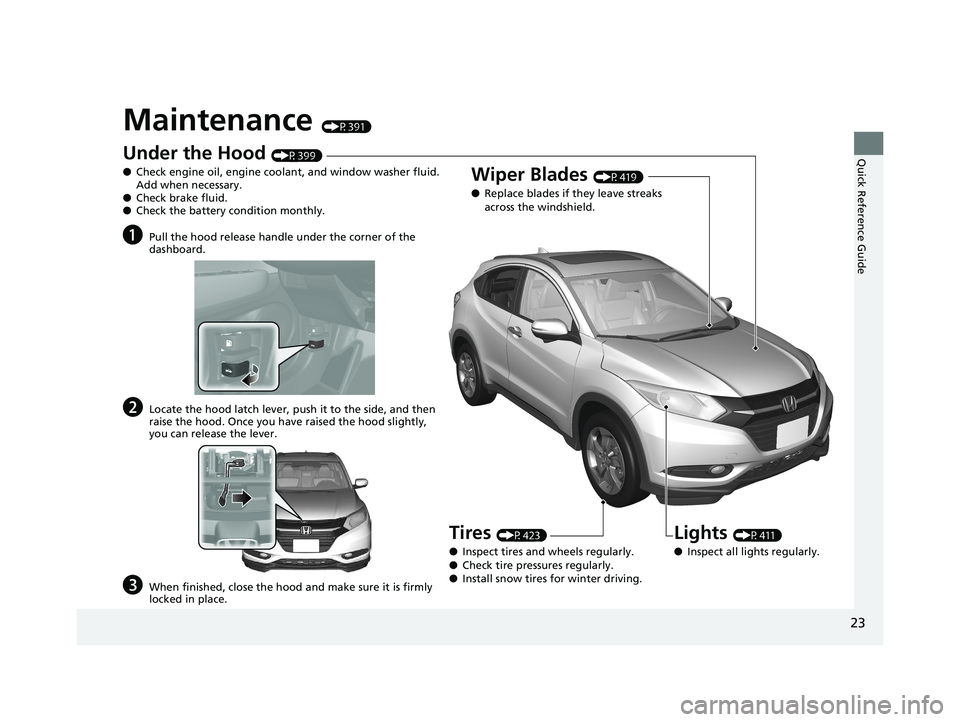
23
Quick Reference Guide
Maintenance (P391)
Under the Hood (P399)
● Check engine oil, engine coolant, and window washer fluid.
Add when necessary.
● Check brake fluid.
● Check the battery condition monthly.
aPull the hood release handle under the corner of the
dashboard.
bLocate the hood latch lever, push it to the side, and then
raise the hood. Once you have raised the hood slightly,
you can release the lever.
cWhen finished, close the hood and make sure it is firmly
locked in place.
Lights (P411)
● Inspect all lights regularly.
Wiper Blades (P419)
● Replace blades if they leave streaks
across the windshield.
Tires (P423)
● Inspect tires and wheels regularly.
● Check tire pressures regularly.
● Install snow tires for winter driving.
18 HR-V-31T7A6200.book 23 ページ 2017年6月30日 金曜日 午後1時23分
Page 47 of 503
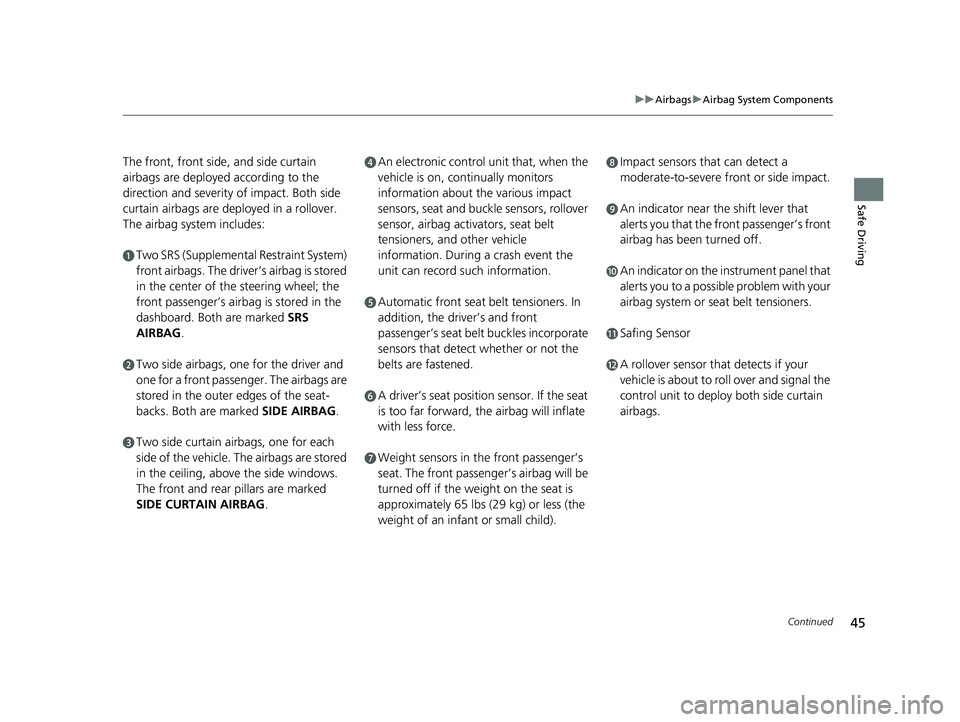
45
uuAirbags uAirbag System Components
Continued
Safe Driving
The front, front side, and side curtain
airbags are deployed according to the
direction and severity of impact. Both side
curtain airbags are deployed in a rollover.
The airbag system includes:
aTwo SRS (Supplemental Restraint System)
front airbags. The driver’s airbag is stored
in the center of the steering wheel; the
front passenger’s airbag is stored in the
dashboard. Both are marked SRS
AIRBAG.
bTwo side airbags, one for the driver and
one for a front passenger. The airbags are
stored in the outer edges of the seat-
backs. Both are marked SIDE AIRBAG.
cTwo side curtain ai rbags, one for each
side of the vehicle. The airbags are stored
in the ceiling, above the side windows.
The front and rear pillars are marked
SIDE CURTAIN AIRBAG .
dAn electronic control unit that, when the
vehicle is on, continually monitors
information about the various impact
sensors, seat and buckle sensors, rollover
sensor, airbag activators, seat belt
tensioners, and other vehicle
information. During a crash event the
unit can record such information.
eAutomatic front seat belt tensioners. In
addition, the driver’s and front
passenger’s seat belt buckles incorporate
sensors that detect whether or not the
belts are fastened.
fA driver’s seat position sensor. If the seat
is too far forward, the airbag will inflate
with less force.
gWeight sensors in the front passenger’s
seat. The front passenger’s airbag will be
turned off if the weight on the seat is
approximately 65 lbs (29 kg) or less (the
weight of an infant or small child).
hImpact sensors that can detect a
moderate-to-severe front or side impact.
iAn indicator near the shift lever that
alerts you that the front passenger’s front
airbag has been turned off.
jAn indicator on the instrument panel that
alerts you to a possible problem with your
airbag system or seat belt tensioners.
kSafing Sensor
lA rollover sensor that detects if your
vehicle is about to ro ll over and signal the
control unit to deploy both side curtain
airbags.
18 HR-V-31T7A6200.book 45 ページ 2017年6月30日 金曜日 午後1時23分
Page 49 of 503
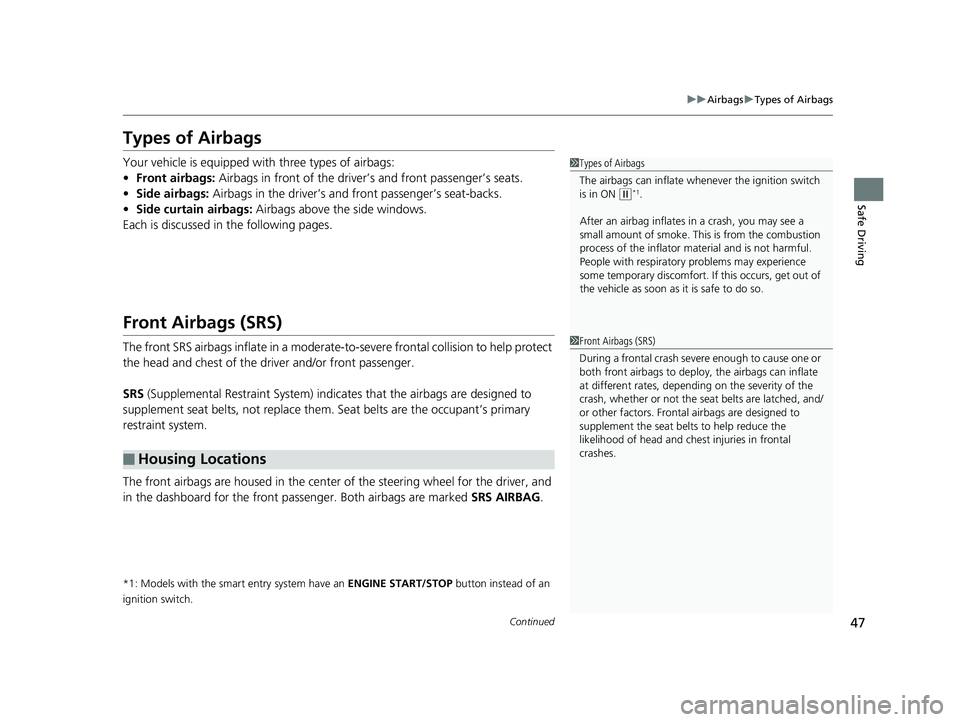
47
uuAirbags uTypes of Airbags
Continued
Safe Driving
Types of Airbags
Your vehicle is equipped wi th three types of airbags:
• Front airbags: Airbags in front of the driver’s and front passenger’s seats.
• Side airbags: Airbags in the driver’s and front passenger’s seat-backs.
• Side curtain airbags: Airbags above the side windows.
Each is discussed in the following pages.
Front Airbags (SRS)
The front SRS airbags inflate in a moderate-to-severe frontal collision to help protect
the head and chest of the driver and/or front passenger.
SRS (Supplemental Restraint System) indica tes that the airbags are designed to
supplement seat belts, not replace them . Seat belts are the occupant’s primary
restraint system.
The front airbags are housed in the center of the steering wheel for the driver, and
in the dashboard for the front pass enger. Both airbags are marked SRS AIRBAG.
*1: Models with the smart entry system have an ENGINE START/STOP button instead of an
ignition switch.
■Housing Locations
1 Types of Airbags
The airbags can inflate whenever the ignition switch
is in ON
(w*1.
After an airbag inflates in a crash, you may see a
small amount of smoke. This is from the combustion
process of the infl ator material and is not harmful.
People with respiratory problems may experience
some temporary discomfort. If this occurs, get out of
the vehicle as soon as it is safe to do so.
1 Front Airbags (SRS)
During a frontal crash severe enough to cause one or
both front airbags to deploy, the airbags can inflate
at different rates, dependi ng on the severity of the
crash, whether or not the se at belts are latched, and/
or other factors. Frontal airbags are designed to
supplement the seat belts to help reduce the
likelihood of head and chest injuries in frontal
crashes.
18 HR-V-31T7A6200.book 47 ページ 2017年6月30日 金曜日 午後1時23分
Page 55 of 503
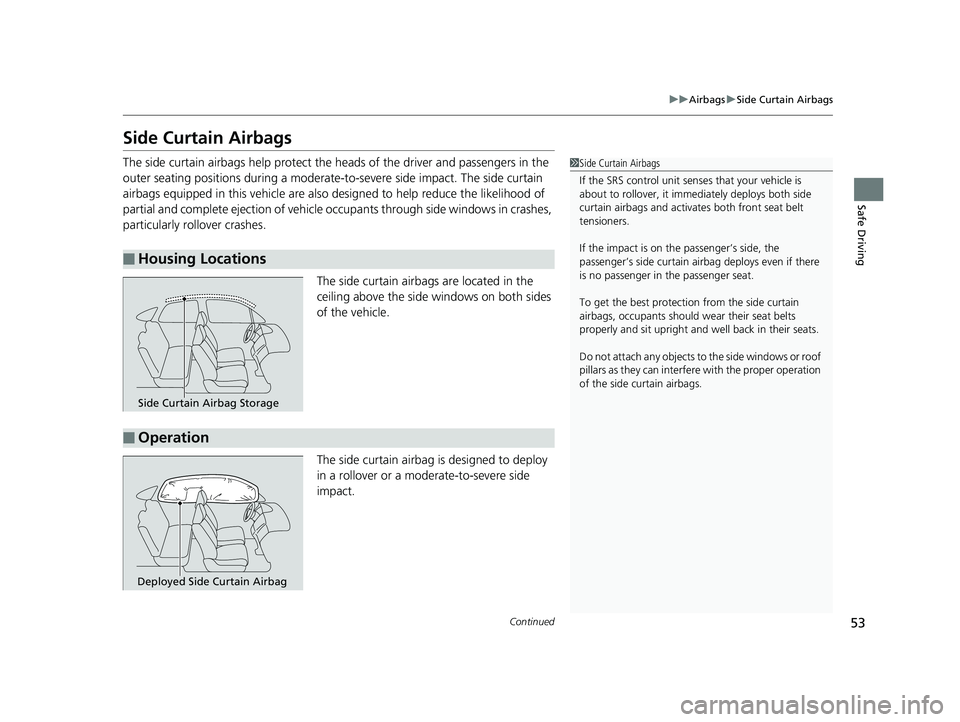
53
uuAirbags uSide Curtain Airbags
Continued
Safe Driving
Side Curtain Airbags
The side curtain airbags help protect the heads of the driver and passengers in the
outer seating positions during a moderate-to -severe side impact. The side curtain
airbags equipped in this vehicle are also designed to help reduce the likelihood of
partial and complete ejection of vehicle occupants through side windows in crashes,
particularly rollover crashes.
The side curtain airbags are located in the
ceiling above the side windows on both sides
of the vehicle.
The side curtain airbag is designed to deploy
in a rollover or a moderate-to-severe side
impact.
■Housing Locations
1 Side Curtain Airbags
If the SRS control unit sens es that your vehicle is
about to rollover, it imme diately deploys both side
curtain airbags and activates both front seat belt
tensioners.
If the impact is on the passenger’s side, the
passenger’s side curtain airbag deploys even if there
is no passenger in the passenger seat.
To get the best protecti on from the side curtain
airbags, occupants should wear their seat belts
properly and sit upr ight and well back in their seats.
Do not attach any objects to the side windows or roof
pillars as they can interfere with the proper operation
of the side curtain airbags.
Side Curtain Airbag Storage
■Operation
Deployed Side Curtain Airbag
18 HR-V-31T7A6200.book 53 ページ 2017年6月30日 金曜日 午後1時23分
Page 60 of 503
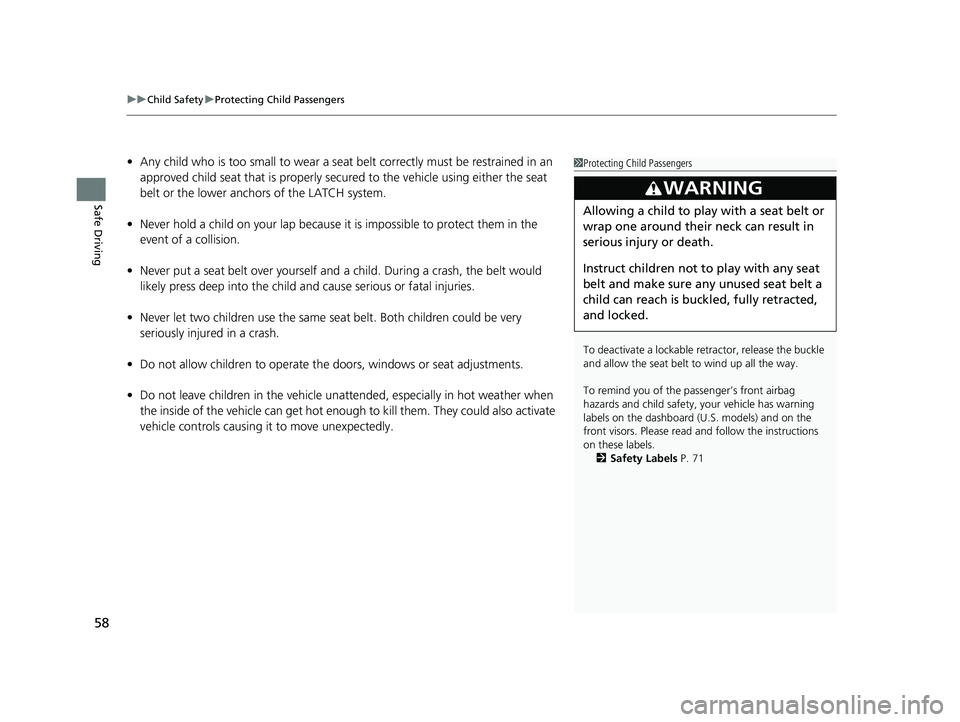
uuChild Safety uProtecting Child Passengers
58
Safe Driving
• Any child who is too small to wear a seat belt correctly must be restrained in an
approved child seat that is properly secu red to the vehicle using either the seat
belt or the lower anchor s of the LATCH system.
• Never hold a child on your lap because it is impossible to protect them in the
event of a collision.
• Never put a seat belt over yourself and a child. During a crash, the belt would
likely press deep into the child an d cause serious or fatal injuries.
• Never let two children use the same seat belt. Both children could be very
seriously injured in a crash.
• Do not allow children to operate the doors, windows or seat adjustments.
• Do not leave children in the vehicle unattended, especially in hot weather when
the inside of the vehicle can get hot enough to kill them. They could also activate
vehicle controls causing it to move unexpectedly.1 Protecting Child Passengers
To deactivate a lockable retractor, release the buckle
and allow the seat belt to wind up all the way.
To remind you of the pa ssenger’s front airbag
hazards and child safety, your vehicle has warning
labels on the dashboard (U.S. models) and on the
front visors. Please read and follow the instructions
on these labels. 2 Safety Labels P. 71
3WARNING
Allowing a child to play with a seat belt or
wrap one around their neck can result in
serious injury or death.
Instruct children not to play with any seat
belt and make sure any unused seat belt a
child can reach is buckled, fully retracted,
and locked.
18 HR-V-31T7A6200.book 58 ページ 2017年6月30日 金曜日 午後1時23分
Page 72 of 503
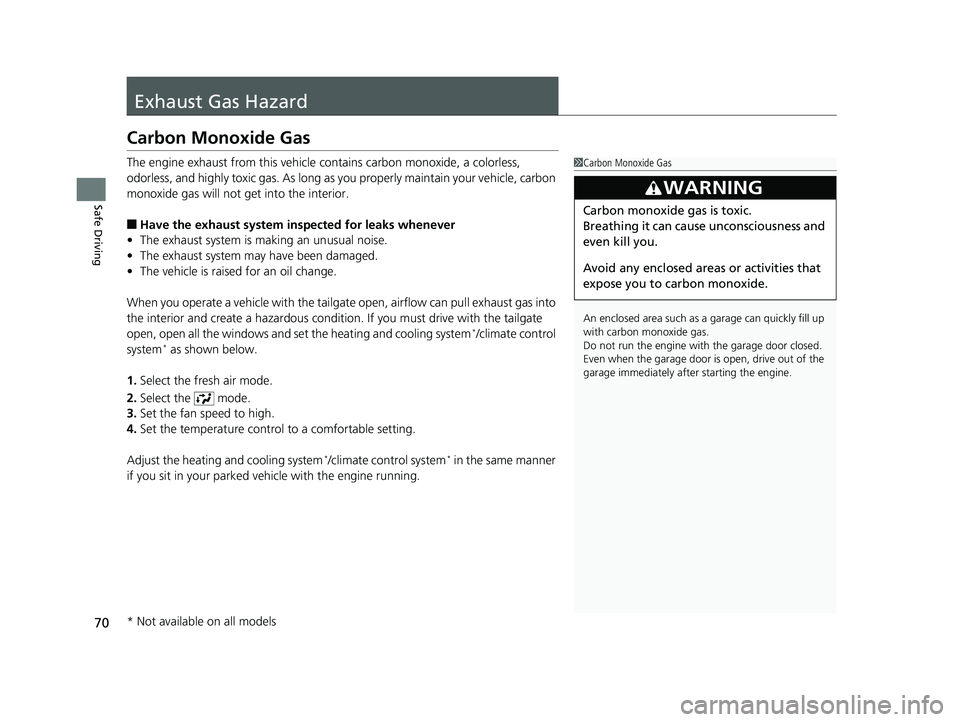
70
Safe Driving
Exhaust Gas Hazard
Carbon Monoxide Gas
The engine exhaust from this vehicle contains carbon monoxide, a colorless,
odorless, and highly toxic gas. As long as you properly maintain your vehicle, carbon
monoxide gas will not get into the interior.
■Have the exhaust system inspected for leaks whenever
• The exhaust system is m aking an unusual noise.
• The exhaust system may have been damaged.
• The vehicle is raised for an oil change.
When you operate a vehicle with the tailgat e open, airflow can pull exhaust gas into
the interior and create a hazardous conditio n. If you must drive with the tailgate
open, open all the windows and set the heating and cooling system
*/climate control
system* as shown below.
1. Select the fresh air mode.
2. Select the mode.
3. Set the fan speed to high.
4. Set the temperature control to a comfortable setting.
Adjust the heating and cooling system
*/climate control system* in the same manner
if you sit in your parked ve hicle with the engine running.
1Carbon Monoxide Gas
An enclosed area such as a garage can quickly fill up
with carbon monoxide gas.
Do not run the engine with the garage door closed.
Even when the garage door is open, drive out of the
garage immediat ely after starting the engine.
3WARNING
Carbon monoxide gas is toxic.
Breathing it can cause unconsciousness and
even kill you.
Avoid any enclosed areas or activities that
expose you to carbon monoxide.
* Not available on all models
18 HR-V-31T7A6200.book 70 ページ 2017年6月30日 金曜日 午後1時23分